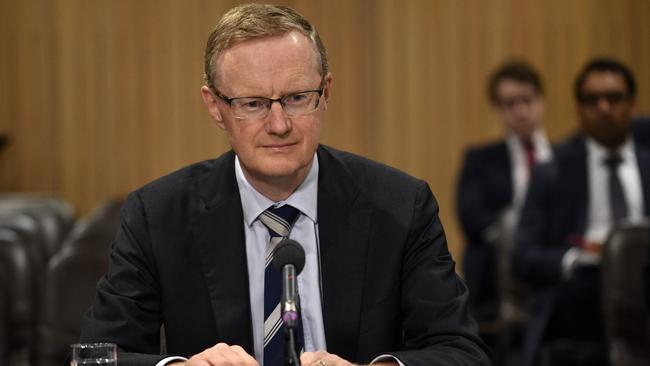Politicians can learns from Lowe’s lesson in banking
As the major bank heads prepare for a grilling, the RBA has provided pollies with a useful primer on the sector.

Armed with a hand-out of graphs to illustrate his comments, Dr Lowe essentially, and very effectively, gave the committee members a primer on the current state of the banks that ought to be quite helpful as they prepare for the first annual grilling of the major bank chief executives that was ordered by the Turnbull Government to head off Labor’s calls for a royal commission.
Lowe’s conclusion was that since the financial crisis, the whole structure of bank interest rates relative to the RBA’s cash rate has changed, with bank rates rising relative to the cash rate. The explanation for why that might have happened lies largely in the post-crisis tide of global regulatory reforms.
He started the explanation with a discussion of bank net interest margins. As he said, net interest margins came down sharply through the 1990s and early 2000s (as the mortgage brokers and securitisers became a competitive force) but have essentially gone sideways over the past decade.
For much of that same period, the difference between the banks’ average lending rate and their average cost of funding had a similar pattern, except that in the past two years it has risen.
A key element of the post-crisis regulatory reforms has been a requirement for banks to hold more, and more high-quality, liquidity.
Dr Lowe said the share of bank assets held in securities had risen from 15 per cent to 20 per cent because of that requirement. So, the banks are holding a lot more of those assets but the average return on those assets is a lot lower (globally it is less than one per cent) than the banks would generate if they lent those funds, he said.
The other big post-crisis regulatory impost has been a very significant increase in regulatory capital requirements, particularly for the four major banks. Capital is the most expensive form of funding.
A common criticism of the major banks is that their returns on equity are too high. Over the past two decades, according to the RBA, the major Australian banks have averaged a return on equity of about 15 per cent, similar to Canada’s banks but higher than banks in the US, Europe and Japan.
The Australian and Canadian banking systems, of course, were far less impacted by the financial crisis than the banks in those other jurisdictions.
It is also worth noting that significant contributors to the majors’ returns on equity (which were approaching 20 per cent pre-crisis) have been massive cost-reductions and a post-crisis bad debt cycle that saw their loan losses at historical lows.
The cost reduction story appears to have run its course — the banks are now investing heavily in technology to prepare for the fintech assault and are also wearing the higher compliance costs of increased regulation — while the bad debt cycle appears to have turned.
That is flowing through to their returns on equity. In the March half, the major banks’ returns on equity averaged 13.8 per cent, a 153 basis point reduction on the same half of 2014-15. Cash earnings were down an average of three per cent.
Dr Lowe went onto to talk about the “pass through” — who has been impacted by the change in the rate structure.
Since the crisis, standard variable mortgage rates have moved up, relative to the cash rate, by about two percentage points and the same was true to an even greater extent for loans to small business, although the RBA noted that the spread between the standard mortgage rates and lowest available rates has increased, with discounts of up to 1.5 percentage point not unusual.
On the other side of bank balance sheets, the cost of long-term debt relative to the cash rate, which spiked about two percentage points during the crisis, is still 1.5 percentage points higher than before the crisis.
Moreover, the cost of deposits relative to the cash rate has gone up a lot as well. Pre-crisis, Dr Lowe said, the average rate paid on deposits was about two percentage points below the cash rate. Now it is very similar to the cash rate. That’s another feature of the post-crisis regulatory changes — the banks are required to hold more stable funding, which generally means more deposits.
It is the combination of the requirement to hold more low-yielding securities to boost liquidity and the need to hold more deposits to improve funding stability that are the key drivers of the shift in the structure of interest rates relative to the cash rate that Dr Lowe described.
The banks generate very low yields on the securities and have competed to bid up the price of deposits, relative to the cash rate, to attract them. The low interest rate environment and regulator-driven changes to the structure of their balance sheets also means the returns on their non-interest-bearing deposits have also fallen sharply.
Dr Lowe made the point that the costs of the change in the regulatory environment could have led to lower profits and lower returns to bank shareholders. Banks could have accepted lower returns on equity.
“My assessment is that the borrowers have largely borne the cost of that, not the shareholders of the banks, and it is an interesting question about who ultimately should bear the cost of that: the shareholders or the borrowers,” he said.
Given the amounts of new shareholder capital the banks have raised since the crisis, an environment where demand for credit is modest and therefore there is only modest volume growth and one in which both costs and bad and doubtful debt charges are rising, the major banks CEOs ought to be able to make a reasonable fist of answering that question.
They might well be able to argue — if not at next month’s hearing then at the next scheduled inquisition in 12 months’ time — that shareholders are increasingly bearing some of the costs of post-crisis regulatory reforms whose impacts and costs are still ratcheting up.






When Philip Lowe made his first appearance before the House of Representative economics committee as the Reserve Bank’s Governor last week he provided the committee members with a very coherent set of insights into the condition and recent workings of the banking sector.